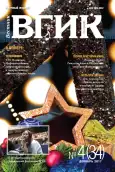Metaphor in Cinema: Specifics of its Creation and Perception
- Authors: Poznin V.F1
-
Affiliations:
- Санкт-Петербургского государственного университета
- Issue: Vol 9, No 4 (2017)
- Pages: 60-70
- Section: PERFORMANCE | ART OF PRESENTATION
- URL: https://journals.eco-vector.com/2074-0832/article/view/14617
- DOI: https://doi.org/10.17816/VGIK9460-70
- ID: 14617
Cite item
Full Text
Abstract
The main feature of a metaphor is the transfer of the characteristics of one object to another one, i.e. categorical shift of meanings and a new semantic content arising as a result of it. Unlike the linguistic metaphor, which is actually a tightened, compressed similarity or contiguity, the local cinema metaphor as a rule is a visual comparison of specific objects. The author analyzes the difference and interaction of verbal and visual metaphors. Some features of creating a non-diegetic cinema metaphor are like a mechanism of creating a hieroglyph, because screen metaphors are often a way of describing an abstract concept through the connection of images of concrete objects. A particular object can acquire a metonymic and metaphorical meaning due to the context of episode. For modern figurative language of cinema a diegetic metaphor is more organic, because this one is a part of the screen narration. A significant role in the creation of the diegetic screen metaphor plays both the previous experience and the short-term memory of the viewer, helping him/ her to apprehend the metaphor. The questions considered in the article are just a small part of the theory of screen metaphor, which includes the consideration of such kinds of metaphor as orientational (spatial), conceptual, dynamic, color and sound metaphor, as well as analysis of a metaphor usage in different genres of animation, documentary, comedy.
Keywords
About the authors
Vitaliy F Poznin
Санкт-Петербургского государственного университета
Author for correspondence.
Email: editor@vestnik-vgik.com
Doctor in Arts, Professor, Broadcast Journalism Department, Saint Petersburg State University, School of Journalism and Mass Communication
References
- Барт Р. Camera lucida. Комментарий к фотографии / Ролан Барт; пер. с фр., послесл. и коммент. Михаила Рыклина. - М.: Ад Маргинем Пресс, 2011. - 272 с.
- Делёз Ж. Кино. - М.: Ад Маргинем Пресс, 2016. - 560 с.
- Лакофф Д., Джонсон М. Метафоры, которыми мы живем: пер. с англ. / под ред. и с предисл. А.Н. Баранова. - М.: Едиториал УРСС, 2004. - 256 с.
- Лотман Ю. Семиотика кино и проблемы киноэстетики. - Таллин: Издательство «Ээсти Раамат», 1973. - 92 с.
- Метц К. Воображаемое означающее. Психоанализ и кино / Кристиан Метц; пер. с фр. Д. Калугина, Н. Мовниной; изд. 2-е. - СПб.: Издательство Европейского университета в Санкт-Петербурге, 2013. - 334 с.
- Якобсон Р. Два аспекта языка и два типа афатических нарушений // Теория метафоры. Сб. - М.: Прогресс, 1990. - C. 110-132.
- Ямпольский М.Б. Память Тиресия. Интертекстуальность и кинематограф. - М.: РИК Культура (Ad Marginem), 1993. - 464 с.
- Coëgnarts M., Kravanja P From Thought to Modality: A Theoretical Framework for Analysing Structural Conceptual Metaphors and Image Metaphors in Film // Image & Narrative, Vol. 13, No 1 (2012). - P 96-113.
- Lakoff, G. The contemporary theory of metaphor. In A. Ortony (Ed.) // Metaphor and Thought (second edition) Cambridge: Cambridge University Press, 1993. - P 202-251.
- Poznin V.F., Skripyuk I.I. Screen image in terms of the psychology of communication // East European Scientific Journal, № 12 (16), 2016, part 1. - Р 51-55.
Supplementary files








